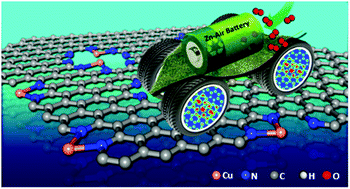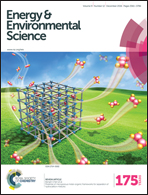Highly doped and exposed Cu(i)–N active sites within graphene towards efficient oxygen reduction for zinc–air batteries†
Abstract
A coordinatively unsaturated copper–nitrogen architecture in copper metalloenzymes is essential for its capability to catalyze the oxygen reduction reaction (ORR). However, the stabilization of analogous active sites in realistic catalysts remains a key challenge. Herein, we report a facile route to synthesize highly doped and exposed copper(I)–nitrogen (Cu(I)–N) active sites within graphene (Cu–N©C) by pyrolysis of coordinatively saturated copper phthalocyanine, which is inert for the ORR, together with dicyandiamide. Cu(I)–N is identified as the active site for catalyzing the ORR by combining physicochemical and electrochemical studies, as well as density function theory calculations. The graphene matrix could stabilize the high density of Cu(I)–N active sites with a copper loading higher than 8.5 wt%, while acting as the electron-conducting path. The ORR activity increases with the specific surface area of the Cu–N©C catalysts due to more exposed Cu(I)–N active sites. The optimum Cu–N©C catalyst demonstrates a high ORR activity and stability, as well as an excellent performance and stability in zinc–air batteries with ultralow catalyst loading.



 Please wait while we load your content...
Please wait while we load your content...